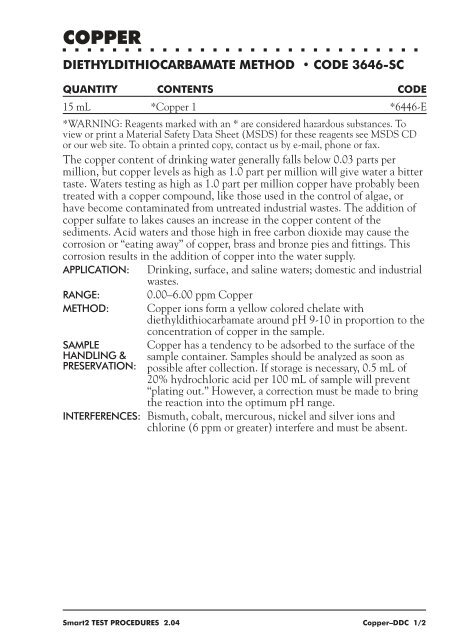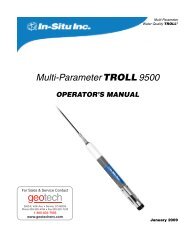TEST INSTRUCTIONS - Geotech Environmental Equipment
TEST INSTRUCTIONS - Geotech Environmental Equipment
TEST INSTRUCTIONS - Geotech Environmental Equipment
You also want an ePaper? Increase the reach of your titles
YUMPU automatically turns print PDFs into web optimized ePapers that Google loves.
COPPER<br />
DIETHYLDITHIOCARBAMATE METHOD CODE 3646-SC<br />
QUANTITY CONTENTS CODE<br />
15 mL *Copper 1 *6446-E<br />
*WARNING: Reagents marked with an * are considered hazardous substances. To<br />
view or print a Material Safety Data Sheet (MSDS) for these reagents see MSDS CD<br />
or our web site. To obtain a printed copy, contact us by e-mail, phone or fax.<br />
The copper content of drinking water generally falls below 0.03 parts per<br />
million, but copper levels as high as 1.0 part per million will give water a bitter<br />
taste. Waters testing as high as 1.0 part per million copper have probably been<br />
treated with a copper compound, like those used in the control of algae, or<br />
have become contaminated from untreated industrial wastes. The addition of<br />
copper sulfate to lakes causes an increase in the copper content of the<br />
sediments. Acid waters and those high in free carbon dioxide may cause the<br />
corrosion or “eating away” of copper, brass and bronze pies and fittings. This<br />
corrosion results in the addition of copper into the water supply.<br />
APPLICATION: Drinking, surface, and saline waters; domestic and industrial<br />
wastes.<br />
RANGE: 0.00–6.00 ppm Copper<br />
METHOD: Copper ions form a yellow colored chelate with<br />
diethyldithiocarbamate around pH 9-10 in proportion to the<br />
SAMPLE<br />
HANDLING &<br />
PRESERVATION:<br />
concentration of copper in the sample.<br />
Copper has a tendency to be adsorbed to the surface of the<br />
sample container. Samples should be analyzed as soon as<br />
possible after collection. If storage is necessary, 0.5 mL of<br />
20% hydrochloric acid per 100 mL of sample will prevent<br />
“plating out.” However, a correction must be made to bring<br />
the reaction into the optimum pH range.<br />
INTERFERENCES: Bismuth, cobalt, mercurous, nickel and silver ions and<br />
chlorine (6 ppm or greater) interfere and must be absent.<br />
Smart2 <strong>TEST</strong> PROCEDURES 2.04 Copper–DDC 1/2

















